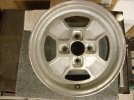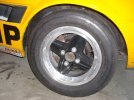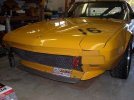I'm starting to look for new tires. In 185/60-13, I can only find the Toyo Proxess R888R, but I've heard they're not very good in the rain - which given the tread, makes sense.
If you look at 175/70-13, there's a lot more options. I was looking on Tires-Easy.com -
https://www.tires-easy.com/175-70-13/maxxis-tires/ma-202/tirecode/TP20541400 and found lots of tires, so I looked for anything with a Treadwear Rating of 500 or less. My thinking is something higher than 500 (more realistically 400) will be fairly hard and not as much fun on windy roads.
But I've never heard of any of the tires listed except for the Toyo Eclipse which has a treadwear rating of 500.
Does anyone have any experience with any of these tires?
Tire and wheel is a matched set, always verified by engineers during the new car development process. If you choose to modify from stock, it is wise to copy what that manufacturer did. For X 1/9:
1974-1978 came with 145HR13 or 145SR13 tires on 4 1/2" wide rims.
Those wheels were mostly tube type. It was a matched set; tube type TT wheel, tube, and tube type tire. Since tube type wheels and tires are an obsolete technology for sports car use, you might want to switch to tubeless wheels. Tubeless wheels have humps inboard of the rim flange which prevent the bead from unseating during hard cornering or evasive maneuvers.
When I had these cars, I would get rid of those TT wheels and upgrade to the steel wheels which came on 1979 and later X cars which were 5 x 13 tubeless wheels. The wider wheel allows support of a wider, lower profile tire like 165/70SR13 which was the standard X tire starting in 1979.
Some people choose to put a larger diameter tire to get the gearing effect (lower rpm at a given road speed) for highway travel. Others choose a smaller diameter tire for quicker acceleration (and consequent more engine noise at cruise).
I selected 175/70TR13 Michelin Defender tires on Fiat Speedline 5 1/2 x 13 tubeless alloy wheels (sometimes known as IRON CROSS style). These fit perfectly with no rubbing except for at full lock, the inside tire shoulder kisses the inner fender liner. There are some good choices for this size tire at tirerack.com for 80 dollars each in the USA. Most people choose wide wheels and tires for cosmetic reasons. The widest original equipment wheel tire combo on mid 1980s X 1/9 was 185/60HR13 on a 5 1/2 x 13 wheel. That was enough for 75hp 1500 FI engine. You can do a functional test to verify that your X needs wider wheels and wider tires:
If your car spins its tires on clean dry pavement during acceleration, or your drive tires spin (burn rubber) when accelerating out of a corner, you may benefit from better performing tires or wider wheels and tires.
5 1/2 x 13 Speedline Iron Cross wheel shown below. Yellow car is 185/60ZR13 on 6 x13 Revolution wheels. On this lowered race car, some fender lip rolling was required to prevent the outside tire shoulder rubbing. At full lock the inside shoulder would touch the inner fender.



